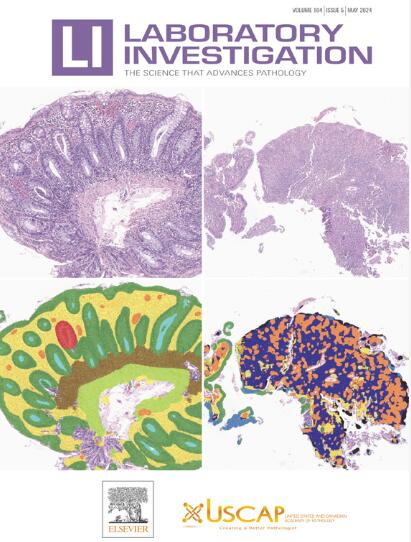肺癌液体活检:纳米流式细胞术检测血液中的非小细胞肺癌。
IF 5.1
2区 医学
Q1 MEDICINE, RESEARCH & EXPERIMENTAL
引用次数: 0
摘要
非小细胞肺癌(NSCLC)仍然是导致全球死亡的主要原因,而目前的筛查和诊断方法往往缺乏敏感性和特异性。为了开发精确、客观、易于获得的 NSCLC 诊断生物标志物,本研究旨在利用病理学领域快速发展的液体活检技术,通过分离外周血样本,富集含有肺源性蛋白(TTF-1 和 SFTPB)的细胞外囊泡(EVs)以及癌症相关蛋白 CD151+ EVs,将 NSCLC 患者与健康对照组区分开来。此外,在实际应用中,我们还建立了一种纳米流式细胞术检测方法,可随时检测血浆中的EVs。与健康对照组相比,NSCLC 患者血浆中 TTF-1+ EVs 和 CD151+ EVs 的数量明显减少(P+ EVs 无显著差异(P>0.05))。对TTF-1+、CD151+和SFTPB+ EVs进行综合分析后,发现组和验证组的曲线下面积(AUC)值分别为0.913和0.854。因此,虽然进一步的验证至关重要,但新开发的技术对NSCLC生物标记物的稳健检测意义重大。本文章由计算机程序翻译,如有差异,请以英文原文为准。
Liquid Biopsy in Lung Cancer: Nano–Flow Cytometry Detection of Non–Small Cell Lung Cancer in Blood
Non–small cell lung cancer (NSCLC) remains a leading cause of global mortality, with current screening and diagnostic methods often lacking in sensitivity and specificity. In our endeavor to develop precise, objective, and easily accessible diagnostic biomarkers for NSCLC, this study aimed to leverage rapidly evolving liquid biopsy techniques in the field of pathology to differentiate NSCLC patients from healthy controls by isolating peripheral blood samples and enriching extracellular vesicles (EVs) containing lung-derived proteins (thyroid transcription factor-1 [TTF-1] and surfactant protein B [SFTPB]), along with the cancer-associated protein CD151+ EVs. Additionally, for practical applications, we established a nano–flow cytometry assay to detect plasma EVs readily. NSCLC patients demonstrated significantly reduced counts of TTF-1+ EVs and CD151+ EVs in plasma compared with healthy controls (P < .0001), whereas SFTPB+ EVs showed no significant difference (P > .05). Integrated analysis of TTF-1+, CD151+, and SFTPB+ EVs yielded an area under the curve values of 0.913 and 0.854 in the discovery and validation cohorts, respectively. Thus, although further validation is essential, the newly developed technologies are of great significance for the robust detection of NSCLC biomarkers.
求助全文
通过发布文献求助,成功后即可免费获取论文全文。
去求助
来源期刊

Laboratory Investigation
医学-病理学
CiteScore
8.30
自引率
0.00%
发文量
125
审稿时长
2 months
期刊介绍:
Laboratory Investigation is an international journal owned by the United States and Canadian Academy of Pathology. Laboratory Investigation offers prompt publication of high-quality original research in all biomedical disciplines relating to the understanding of human disease and the application of new methods to the diagnosis of disease. Both human and experimental studies are welcome.
 求助内容:
求助内容: 应助结果提醒方式:
应助结果提醒方式:


